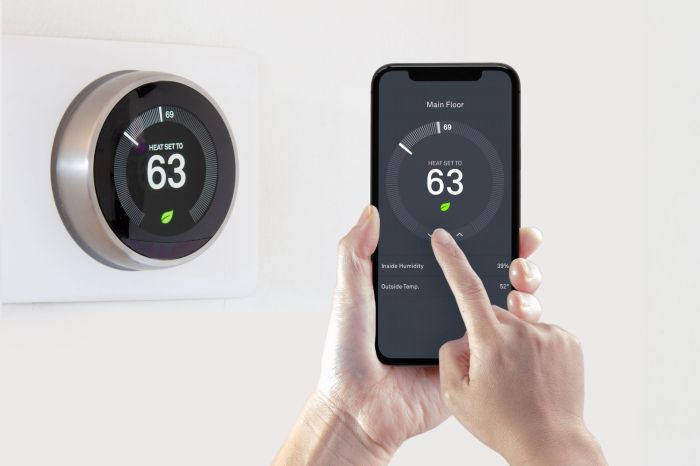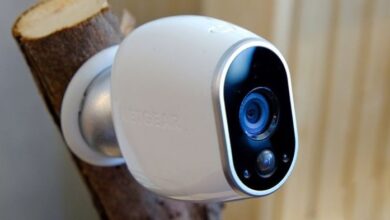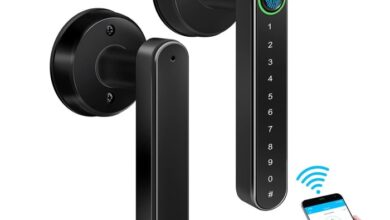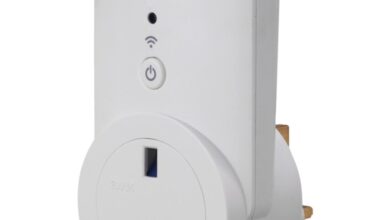Smart Thermostat Your Guide to Energy Savings
Smart Thermostat: Imagine a home that anticipates your needs, adjusting its temperature before you even step inside. This isn’t science fiction; it’s the reality offered by smart thermostats. These ingenious devices go beyond simple temperature control, learning your habits, optimizing energy consumption, and seamlessly integrating with your smart home ecosystem. This deep dive explores everything you need to know about smart thermostats, from their core functionalities and energy-saving potential to the latest advanced features and potential security considerations.
Prepare to be amazed by the possibilities.
From understanding how these devices learn your preferences and the various connectivity options available (Wi-Fi, Bluetooth, Z-Wave, etc.), to comparing them to traditional thermostats, we’ll unpack the benefits and considerations. We’ll also delve into the significant energy savings you can achieve, exploring factors like climate, insulation, and calculating your return on investment. Discover how smart thermostats effortlessly integrate with other smart home devices, enhancing convenience and security.
We’ll examine user interfaces, installation processes, and address potential security and privacy concerns head-on. Finally, we’ll uncover the latest advanced features, such as geofencing and adaptive learning, and explore the cost and availability of various models on the market.
Smart Thermostat Functionality
Smart thermostats represent a significant upgrade from their traditional counterparts, offering a blend of convenience, energy efficiency, and sophisticated control over your home’s climate. They go beyond simple temperature regulation, learning your habits and adapting to optimize comfort and minimize energy waste. This translates to lower energy bills and a more sustainable approach to home heating and cooling. Think of it as having a personal climate assistant constantly working to improve your home’s environment.Smart thermostats achieve this through a combination of advanced features and user-friendly interfaces.
Their core functionality revolves around programmable scheduling, remote access, and intelligent learning algorithms. This allows for personalized comfort settings, precise temperature control, and the ability to monitor energy consumption, providing valuable insights into your home’s energy use.
Core Functions of a Smart Thermostat
Smart thermostats offer a range of features beyond basic temperature control. They typically include programmable scheduling, allowing you to set different temperatures for various times of the day or week. This functionality alone can lead to significant energy savings by automatically adjusting the temperature when you’re away or asleep. Remote access via a smartphone app allows you to control your thermostat from anywhere, ensuring your home is comfortable when you arrive.
Many models also incorporate geofencing, automatically adjusting the temperature based on your location. This means your home will be at the perfect temperature when you get home, and will adjust to conserve energy when you are away. Finally, energy usage reporting provides valuable data to help users understand their energy consumption patterns and identify areas for improvement.
This data-driven approach empowers homeowners to make informed decisions about their energy usage.
Learning User Preferences
A key differentiator of smart thermostats is their ability to learn and adapt to your preferences. Through sophisticated algorithms, these devices analyze your heating and cooling patterns over time. For example, if you consistently adjust the temperature upwards in the evenings, the thermostat will learn this preference and automatically adjust accordingly. This learning process eliminates the need for constant manual adjustments, optimizing comfort and minimizing energy waste.
This self-learning capability goes beyond simple scheduling; it anticipates your needs and proactively adjusts the temperature to match your lifestyle. Consider it as having a personal energy management system constantly adapting to your routines and habits. For instance, Nest Learning Thermostat is a prime example of this capability.
Connectivity Options
Smart thermostats typically connect to your home network via Wi-Fi, enabling remote access and control through a dedicated smartphone app. Some models also offer Bluetooth connectivity for local control, allowing for setup and adjustments without relying on a Wi-Fi connection. However, Wi-Fi is essential for the advanced features, such as remote access and over-the-air software updates. The availability of specific connectivity options varies between models, so it’s crucial to check the specifications before purchasing.
While Wi-Fi is the most common method, the integration of other smart home ecosystems may also leverage different protocols. The ability to integrate seamlessly with other smart home devices is a crucial feature for a fully connected home.
Comparison of Smart and Traditional Thermostats
| Feature | Smart Thermostat | Traditional Thermostat |
|---|---|---|
| Connectivity | Wi-Fi, Bluetooth (often) | None |
| Programmability | Advanced, learning algorithms | Basic, manual scheduling |
| Remote Access | Yes, via smartphone app | No |
| Energy Efficiency | Generally higher due to learning and optimization | Lower, reliant on user behavior |
| Cost | Higher initial purchase price | Lower initial purchase price |
Energy Efficiency and Savings
Smart thermostats are revolutionizing home energy management, offering significant potential for cost reduction and environmental responsibility. By learning your heating and cooling preferences and adjusting temperatures automatically, these devices optimize energy consumption, leading to noticeable savings on your energy bills. This translates not only to financial benefits but also to a reduced carbon footprint, contributing to a more sustainable lifestyle.Smart thermostats achieve energy savings through a combination of intelligent features.
They learn your routines, automatically adjusting temperatures when you’re away or asleep, preventing energy waste during unoccupied periods. Advanced algorithms analyze historical data to predict your comfort preferences and optimize energy usage accordingly. This proactive approach minimizes unnecessary heating or cooling, directly impacting your energy consumption.
Maximizing Energy Savings
Several scenarios highlight the significant energy savings achievable with a smart thermostat. For instance, geofencing capabilities automatically adjust the temperature when you leave home and pre-heat or pre-cool your house before you arrive, ensuring optimal comfort without unnecessary energy expenditure. Furthermore, smart thermostats can integrate with other smart home devices, creating automated systems that further enhance energy efficiency.
Imagine a system that automatically lowers the temperature when your smart lighting indicates the house is unoccupied, or one that adjusts the thermostat based on real-time energy pricing, ensuring you’re always using energy at the most cost-effective times.
Factors Influencing Energy Savings
The extent of energy savings realized from a smart thermostat is influenced by several factors. Climate plays a crucial role; in regions with extreme temperatures, the potential for savings is significantly higher. Similarly, the level of home insulation greatly impacts energy efficiency. A well-insulated home requires less energy to maintain a comfortable temperature, maximizing the impact of the smart thermostat.
The size of your home and the type of heating and cooling system also influence the overall energy savings. Older, less efficient systems may see more dramatic improvements compared to newer, high-efficiency models.
Return on Investment (ROI) of a Smart Thermostat
The financial benefits of a smart thermostat are significant, with a strong return on investment (ROI).
- Reduced Energy Bills: Depending on your usage and climate, you can expect to see a reduction in your monthly energy bills, often ranging from 10% to 15%, or even more in some cases. For example, a household with an average monthly energy bill of $150 could save $15 to $22.50 per month.
- Increased Home Value: Smart home features, including smart thermostats, are increasingly desirable to potential homebuyers, potentially increasing your home’s resale value.
- Government Incentives: Some regions offer rebates or tax credits for installing energy-efficient home upgrades, including smart thermostats. These incentives can substantially reduce the upfront cost and accelerate the ROI.
- Long-Term Savings: The cumulative savings over the lifespan of the smart thermostat significantly outweigh the initial investment cost. Considering a typical lifespan of 5-10 years, the long-term financial benefits are substantial. For instance, an annual savings of $180 over five years equates to $900 in savings, easily surpassing the initial cost of most smart thermostats.
“The ROI on a smart thermostat is not just about the money saved on energy bills; it’s about the comfort, convenience, and contribution to a more sustainable future.”
Smart Home Integration

Smart thermostats aren’t just about saving energy; they’re key players in creating a truly connected and convenient smart home. Their ability to seamlessly integrate with other smart devices elevates the user experience, offering automation and control beyond simple temperature adjustments. This integration unlocks a new level of home management, optimizing energy consumption while enhancing comfort and security. Think of it as the conductor of your smart home orchestra, harmonizing various devices for a more efficient and responsive living space.Smart thermostats effortlessly integrate with a wide array of smart home devices and ecosystems.
This interconnectivity allows for sophisticated automation and personalized control schemes, transforming your home into a responsive and intuitive environment. The potential for streamlined management and energy savings is substantial, impacting not just your comfort but also your wallet.
Smart Home Ecosystem Compatibility
The compatibility of smart thermostats varies depending on the brand and model. However, most leading brands offer broad compatibility with popular smart home ecosystems like Google Home, Amazon Alexa, Apple HomeKit, and Samsung SmartThings. For example, a Nest Learning Thermostat can easily integrate with Google Home, allowing voice control over temperature settings. Similarly, an Ecobee SmartThermostat can be incorporated into an Amazon Alexa system, enabling users to adjust temperatures through voice commands.
This broad compatibility ensures that users can integrate their smart thermostat into their existing smart home setup regardless of their preferred platform. The ease of integration is a crucial factor in maximizing the benefits of a smart thermostat.
Remote Control Capabilities
Remote access to your smart thermostat is a game-changer. Using a smartphone app, you can adjust the temperature of your home remotely, ensuring optimal comfort before you even arrive. This is particularly beneficial for those who want to pre-heat or pre-cool their homes, maximizing energy efficiency. Imagine arriving home to a perfectly comfortable temperature, eliminating the need to wait for your home to reach the desired climate.
Many smart thermostats also offer geofencing capabilities, automatically adjusting the temperature based on your location, further enhancing energy savings. This feature automatically adjusts the temperature based on your phone’s location, turning the heating or cooling down when you are away from home and turning it back on as you approach. For example, if you leave for work, the thermostat will automatically switch to an energy-saving mode; upon returning home, it will adjust to your preferred temperature.
Seamless Integration Scenario
Imagine this: You’re away on vacation. Your smart security system detects an unauthorized entry attempt. Simultaneously, your smart thermostat, integrated with the security system, triggers an alert on your smartphone and immediately adjusts the temperature to an energy-saving mode to deter potential intruders by making the house seem unoccupied. This is followed by your smart lights turning on in a pre-programmed pattern to further mimic occupancy, adding another layer of security.
Upon your return, the system automatically reverts to your preferred settings, creating a welcoming and comfortable environment. This interconnectedness provides a level of security and convenience that goes beyond the capabilities of individual smart devices. The scenario highlights the synergy between different smart home devices, illustrating how a smart thermostat can become an integral part of a comprehensive home automation system.
This illustrates the potential for advanced automation and the enhanced security and comfort it provides.
User Interface and Experience
A smart thermostat’s user interface (UI) is crucial for its adoption and effectiveness. A poorly designed interface can lead to user frustration, hindering energy savings and overall satisfaction. Conversely, a well-designed UI empowers users to easily manage their home’s temperature, leading to increased comfort and energy efficiency. This section delves into the various UI types, assesses their usability, and proposes improvements for optimal user experience.
Smart thermostats offer a range of interfaces designed to cater to diverse user preferences and technological comfort levels. The primary goal is to provide intuitive control over complex systems, translating technical functionalities into simple, user-friendly interactions. Success hinges on seamless navigation, clear information presentation, and immediate feedback.
App-Based Interfaces
App-based interfaces provide remote control and monitoring capabilities, allowing users to adjust their thermostat settings from anywhere with an internet connection. Many leading smart thermostat manufacturers offer dedicated mobile applications featuring intuitive dashboards, detailed energy usage reports, and remote scheduling options. For example, the Nest app is known for its clean design and straightforward navigation, while other apps may prioritize advanced features, potentially leading to a steeper learning curve for less tech-savvy users.
A key challenge with app-based interfaces is ensuring consistent performance across various operating systems and devices. Improvements could include incorporating personalized onboarding tutorials and contextual help features within the app itself.
Touchscreen Interfaces
Touchscreen interfaces offer a direct and immediate way to interact with the thermostat. The physical presence of a touchscreen allows for quick adjustments and visual feedback, which is particularly beneficial for users who prefer a tactile experience. However, the limited screen real estate on many thermostats can make displaying complex information challenging. A potential usability challenge is the readability of the screen in low-light conditions or from a distance.
Improvements could include using high-contrast displays, incorporating larger font sizes, and implementing customizable display options. For example, a larger, more responsive touchscreen with adjustable brightness would greatly enhance the user experience.
Voice Control Interfaces
Voice control interfaces, often integrated with smart home assistants like Alexa or Google Assistant, offer hands-free control and convenience. Users can simply issue voice commands to adjust the temperature, change modes, or inquire about energy usage. The ease of use makes this interface particularly attractive to elderly users or individuals with mobility limitations. However, potential challenges include ensuring accurate voice recognition across different accents and background noise levels.
Improvements could focus on enhancing the accuracy of voice commands and providing clear verbal feedback to confirm user actions. For instance, the thermostat could verbally confirm the temperature change request and the new set temperature.
Mock-up of a User-Friendly Interface
A user-friendly smart thermostat interface should prioritize clarity, simplicity, and accessibility. The following features would contribute to an enhanced user experience:
- Large, clear display: Easily readable temperature and mode information, even from a distance.
- Intuitive controls: Simple icons and gestures for adjusting temperature and scheduling.
- Visual energy usage feedback: Graphs and charts to illustrate energy consumption and savings.
- Personalized settings: Options for customizing display preferences and notification settings.
- Voice control integration: Seamless compatibility with popular voice assistants.
- Remote access and control: Full functionality through a dedicated mobile application.
- Contextual help: In-app tutorials and readily available support information.
Installation and Setup
Installing a smart thermostat might seem daunting, but with a little patience and the right instructions, it’s a manageable DIY project that can significantly improve your home’s energy efficiency and comfort. This section breaks down the process step-by-step, offering troubleshooting tips and comparisons between leading brands to help you choose the best fit for your home.
Smart Thermostat Installation Steps
The installation process generally involves removing your old thermostat, carefully noting the wiring configuration, and then attaching and wiring the new smart thermostat. This requires basic DIY skills and familiarity with electrical wiring. Always turn off the power to the system at the breaker box before beginning any work to ensure your safety. Detailed, illustrated instructions are usually provided with the thermostat, and many manufacturers also offer helpful video tutorials online.
Remember to consult your specific thermostat’s manual for precise instructions.
Configuring the Thermostat with Wi-Fi
Connecting your smart thermostat to your home Wi-Fi network is crucial for accessing its remote control features and data analysis capabilities. Most thermostats use a simple setup process via a mobile app. The app will guide you through the steps, which typically involve selecting your Wi-Fi network and entering your password. Some thermostats may use a QR code for faster pairing, while others might require manual entry of the network credentials.
Ensure your phone is connected to your home Wi-Fi network during the setup process. A strong and stable Wi-Fi signal is vital for reliable operation. Placement of the thermostat is also important; avoid locations with significant interference from appliances or other electronic devices.
Troubleshooting Common Installation Problems
Despite clear instructions, installation issues can arise. One common problem is incorrect wiring. Double-checking the wiring diagram against your old thermostat’s configuration is crucial. If the thermostat doesn’t power on, verify the power supply at the breaker box. If the Wi-Fi connection fails, check your router’s signal strength and try restarting both your router and the thermostat.
App-related issues can often be resolved by checking for updates or reinstalling the app. In case of persistent problems, consulting the manufacturer’s customer support or a qualified electrician is recommended. Remember, safety should always be your top priority.
Smart Thermostat Brand Comparison: Installation and Setup
Different smart thermostat brands offer varying levels of ease of installation and setup time. This can depend on factors like the design of the thermostat, the intuitiveness of the app, and the quality of the instructions provided. While precise times vary, a general comparison is provided below. Remember that these are estimates and actual installation times can vary depending on individual experience and specific circumstances.
| Brand | Ease of Installation | Estimated Setup Time | Additional Notes |
|---|---|---|---|
| Nest | Easy | 15-30 minutes | Intuitive app and clear instructions. |
| Ecobee | Easy to Moderate | 20-45 minutes | More complex wiring options for certain models. |
| Honeywell | Moderate | 30-60 minutes | Some models require more technical knowledge. |
| Emerson | Easy to Moderate | 20-40 minutes | App interface may be less intuitive for some users. |
Security and Privacy Concerns
Smart thermostats, while offering convenience and energy savings, introduce new security and privacy considerations. Understanding these risks and implementing appropriate safeguards is crucial for protecting your home and personal data. The interconnected nature of these devices means potential vulnerabilities exist, impacting both the security of your home and the privacy of your energy consumption data.The potential for unauthorized access and data breaches is a significant concern.
Malicious actors could exploit vulnerabilities in the device’s software or network connection to gain control, potentially manipulating your heating and cooling settings, or even accessing your home network. Data privacy concerns also arise from the collection and storage of your energy usage patterns. This information, while seemingly innocuous, can reveal details about your daily routines and habits, potentially making you a target for various types of attacks or misuse.
Data Privacy Practices of Manufacturers
Manufacturers are increasingly recognizing the importance of data privacy and are implementing measures to address these concerns. Many employ encryption to protect data transmitted between the thermostat and their servers. They also often have privacy policies outlining how data is collected, used, and protected. Transparency regarding data retention policies is becoming increasingly common, with some companies offering users control over the type and amount of data collected.
For example, some manufacturers allow users to opt out of certain data collection practices, providing greater control over their privacy. It is important to review these policies carefully before purchasing and installing a smart thermostat.
Securing Your Smart Thermostat
Implementing strong security practices is essential to mitigate potential risks. This includes choosing a strong, unique password for your thermostat and its associated app, regularly updating the device’s firmware to patch security vulnerabilities, and ensuring your home Wi-Fi network is also well-protected with a strong password and encryption. Consider using a separate, dedicated network for your smart home devices to further isolate them from the rest of your network.
This approach helps to contain the impact of any potential compromise, limiting the damage to your smart thermostat rather than affecting your entire network. Regularly reviewing your network security settings and updating your router’s firmware are also recommended best practices.
The Importance of Strong Passwords and Software Updates, Smart Thermostat
Strong passwords, incorporating a mix of uppercase and lowercase letters, numbers, and symbols, are crucial for preventing unauthorized access. Regularly changing passwords, especially if you suspect a security breach, is a vital security measure. Furthermore, consistently updating the thermostat’s software is essential to patch known security vulnerabilities. Manufacturers frequently release updates addressing bugs and security flaws, so staying up-to-date is crucial for maintaining the security of your device.
Ignoring software updates significantly increases the risk of exploitation by malicious actors. For instance, a vulnerability in older firmware could allow remote access, potentially leading to the manipulation of your heating and cooling system or even broader network access.
Advanced Features and Technologies
Smart thermostats have evolved beyond basic temperature control, incorporating sophisticated features that significantly enhance user experience and energy efficiency. These advanced functionalities leverage technologies like geofencing and adaptive learning to optimize heating and cooling schedules, resulting in substantial cost savings and a more comfortable home environment. Understanding these features is key to unlocking the full potential of your smart thermostat.Geofencing and Adaptive Learning Enhance Energy Efficiency and User ExperienceGeofencing uses your smartphone’s location to automatically adjust your thermostat’s settings based on whether you’re home or away.
When you leave, the system automatically switches to energy-saving mode, lowering the temperature to a pre-set level. Upon your return, it reverts to your preferred comfort settings, ensuring a warm welcome. This simple yet effective feature eliminates the need for manual adjustments, preventing energy waste when the house is unoccupied. Adaptive learning algorithms analyze your usage patterns over time, identifying your preferred temperatures at different times of the day and adjusting the schedule accordingly.
This personalized approach ensures optimal comfort while minimizing energy consumption. The system learns from your behavior, refining its predictions and adjustments to become increasingly efficient over time.
Geofencing Implementation Across Brands
Different smart thermostat brands implement geofencing with varying levels of sophistication. For instance, some may offer basic geofencing that simply triggers a change in temperature based on proximity, while others provide more nuanced control, allowing for customized settings based on the number of people detected at home or the time of day. Some systems even integrate with other smart home devices, using occupancy sensors to further refine geofencing accuracy.
Consider Nest’s Home/Away Assist, which uses location data to adjust temperatures automatically, or Ecobee’s similar feature that leverages both smartphone location and sensor data for enhanced accuracy. These differences in implementation can significantly impact the user experience and overall energy savings.
Illustrative Example of Adaptive Learning
Imagine a household where the occupants consistently prefer a slightly warmer temperature in the evenings after work. A smart thermostat with adaptive learning capabilities will recognize this pattern over several days. It will then automatically adjust the evening schedule, preemptively increasing the temperature slightly before the usual return time. This anticipatory behavior minimizes energy waste associated with rapidly heating or cooling the home.
Contrast this with a thermostat requiring manual adjustments every day; the adaptive learning feature anticipates needs and proactively optimizes energy use. This proactive approach demonstrates the clear benefits of using advanced features for both comfort and efficiency.
Comparison of Advanced Features
A direct comparison reveals significant differences in the capabilities and sophistication of advanced features across various brands. While many thermostats offer basic geofencing, the level of integration with other smart home devices and the sophistication of their adaptive learning algorithms vary considerably. Some brands offer more granular control over settings, allowing users to fine-tune parameters for optimal performance.
Others provide more comprehensive reporting and analytics, allowing users to track their energy consumption and identify areas for improvement. These variations highlight the importance of researching different brands and models before making a purchase to find the best fit for individual needs and preferences. For example, a family with a busy schedule might benefit from a system with highly accurate geofencing and sophisticated adaptive learning, while a single person might find a simpler system perfectly adequate.
Cost and Availability
Smart thermostats offer significant benefits, but their adoption hinges on factors beyond just technological advancement. Understanding the cost and accessibility of these devices is crucial for both consumers and the industry alike. This section delves into the pricing landscape, the elements influencing costs, and regional availability to provide a comprehensive overview.The price of a smart thermostat varies considerably depending on several key factors.
While some budget-friendly options are available, others boast advanced features and premium designs that command a higher price point. This range reflects the diverse needs and budgets of potential consumers, ensuring a product exists to meet a variety of requirements.
Price Comparison of Smart Thermostat Models
A wide range of smart thermostats exists, each catering to different needs and budgets. Entry-level models can be found for as little as $100, offering basic smart features like remote control and scheduling. Mid-range options, typically priced between $150 and $250, usually include more advanced features such as geofencing and voice control integration. High-end models, priced above $300, often incorporate sophisticated functionalities like advanced learning algorithms, high-resolution displays, and integration with extensive smart home ecosystems.
For example, a basic model from a lesser-known brand might cost around $100, while a Nest Learning Thermostat could cost upwards of $250.
Factors Influencing Smart Thermostat Costs
Several key factors contribute to the overall cost of a smart thermostat. Brand recognition plays a significant role, with established brands like Nest and Ecobee commanding higher prices due to their reputation and established user base. The inclusion of advanced features, such as integrated sensors, air quality monitoring, and advanced algorithms for energy optimization, also directly impacts the final price.
Furthermore, the materials used in the construction of the thermostat, the quality of the display, and the overall design aesthetic all contribute to the cost variation across models. For instance, a thermostat with a large, high-resolution color touchscreen will naturally be more expensive than one with a simpler monochrome display.
Regional Availability of Smart Thermostats
The availability of smart thermostats varies geographically. In developed countries with robust e-commerce infrastructure and high technology adoption rates, these devices are widely available both online and in physical retail stores. However, in less developed regions or those with limited access to online shopping, availability may be more restricted, often limited to larger cities or specialized electronics retailers.
Distribution networks and import regulations also play a significant role in influencing regional availability and pricing discrepancies. For instance, a particular model might be readily available in North America but only available through limited channels in certain parts of Asia.
Price Range Visualization
Imagine a horizontal bar graph. The x-axis represents price, ranging from $100 to $400. The y-axis represents different smart thermostat brands and models. Shorter bars would represent less expensive models, while longer bars represent more expensive models. This visual representation would show the price clustering around different price points, highlighting the range and variability in pricing across the market.
For example, a cluster of shorter bars would be present at the lower end representing budget-friendly models, while a few longer bars would be present at the higher end for premium models.
Closure: Smart Thermostat
Smart thermostats represent a significant leap forward in home automation, offering a compelling blend of convenience, energy efficiency, and cost savings. By understanding their capabilities, integrating them effectively into your smart home, and addressing potential security concerns, you can unlock a new level of comfort and control. The initial investment quickly pays for itself through reduced energy bills, making smart thermostats a worthwhile upgrade for any homeowner seeking a more efficient and connected living experience.
So, embrace the future of home climate control and experience the difference a smart thermostat can make.









